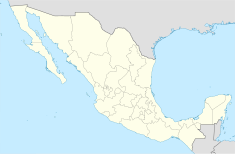Casas Grandes
| Casas Grandes | |
|---|---|

A view of Paquimé, Casas Grandes
|
|
| Location | Chihuahua, Mexico |
| Coordinates | 30°21′58.67″N 107°56′50.74″W / 30.3662972°N 107.9474278°WCoordinates: 30°21′58.67″N 107°56′50.74″W / 30.3662972°N 107.9474278°W |
| Built | 1130 CE |
| Rebuilt | 1350 CE |
| Official name: Archaeological Zone of Paquimé, Casas Grandes | |
| Type | Cultural |
| Criteria | iii, iv |
| Designated | 1998 (22nd session) |
| Reference no. | 560 |
| State Party | Mexico |
| Region | Latin America and the Caribbean |
Casas Grandes (Spanish for Great Houses; also known as Paquimé) is a prehistoric archaeological site in the northern Mexican state of Chihuahua. Construction of the site is attributed to the Mogollon culture. Casas Grandes has been designated a UNESCO World Heritage Site and is under the purview of INAH.
Casas Grandes is one of the largest and most complex Mogollon culture sites in the region. Settlement began after 1130 CE, and would see the larger buildings developed into multi-storied dwellings after 1350 CE. The community was abandoned approximately 1450 CE. Cases Grandes is regarded as one of the most significant Mogollon archaeological zones in the northwestern Mexico region, linking it to other sites in Arizona and New Mexico in the United States, and exhibiting the expanse of the Mogollon sphere of influence.
Casas Grandes complex is located in a wide, fertile valley on the Casas Grandes or San Miguel River, 35 miles (56 km) south of Janos and 150 miles (240 km) northwest of the state capital, the city of Chihuahua. The settlement relied on irrigation to support its agriculture.
The archaeological zone is contained within the eponymous modern municipio (municipality) of Casas Grandes. The valley and region have been inhabited by indigenous groups for thousands of years.
Between CE 1130 and 1300, the area's inhabitants began to congregate in small settlements in this wide fertile valley. The largest identified settlement is known today as Paquimé or Casas Grandes. It began as a group of 20 or more house clusters, each with a plaza and enclosing wall. These single-story adobe dwellings shared a common water system. Evidence shows that Paquimé had a complex water control system that included underground drain systems, reservoirs, channels for water to get to the homes, and a sewage system.
...
Wikipedia

